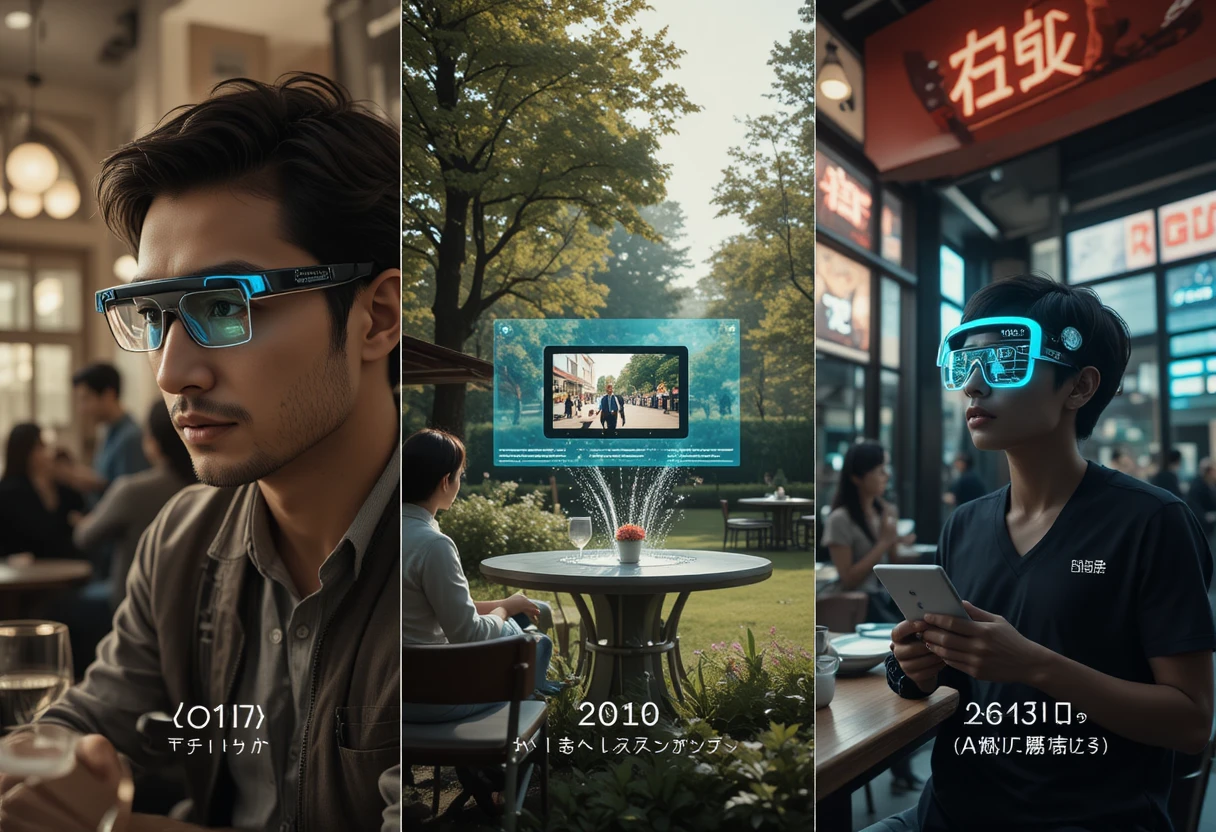Augmented Reality Glasses
The Dawn of the Post-Screen Era
In 2025, augmented reality (AR) glasses have transcended prototype hype to become the primary interface between humans and digital information. Over 240 million units ship annually, Apple Vision Lite leads with 38% market share, and enterprise adoption in manufacturing, medicine, and logistics exceeds $28 billion. These featherweight devices—averaging 42 grams—overlay 8K-per-eye micro-OLED holograms onto the real world at 120 Hz, powered by AI co-processors that render context-aware digital twins in 4 ms. From real-time language translation in Tokyo cafés to remote surgery guidance in rural Kenya, AR glasses are dissolving the boundary between physical and virtual.
This 3,000-word deep dive explores the evolution, optics and display breakthroughs, AI integration, 2025 flagship devices, industry transformations, privacy debates, and 2030 roadmap—proving that the screen is dead; the world is the canvas.
Evolution of AR Glasses
2013–2019: The Clunky Pioneers
The journey began with Google Glass Enterprise Edition (2013)—a monocular HUD with 640×360 resolution, 5 MP camera, and bone conduction audio. Priced at $1,500, it faced privacy backlash (“Glassholes”) and battery life under 2 hours. Microsoft HoloLens 1 (2016) introduced spatial mapping and holographic anchoring, but at 579 g and $3,500, it remained a developer tool.
Magic Leap One (2018) promised photorealistic lightfields but delivered 50° FOV, motion sickness, and $2,300 price—leading to layoffs.
2020–2023: Waveguide Maturation
Nreal Light (2020) weighed 88 g, used birdbath optics, and tethered to phones. Facebook Reality Labs (2021) demoed pancake lenses and varifocal displays, reducing thickness to 18 mm.
Apple Glass prototypes (2022 leaks) revealed Sony micro-OLED and LiDAR depth sensing. Qualcomm Snapdragon AR1 (2023) integrated 5G + AI on-chip, enabling untethered operation.
2024–2025: The Consumer Tipping Point
Apple Vision Lite (June 2025) launches at $1,199, weighing 48 g, with dual 4K micro-OLED, eye-tracking, and hand gesture control. Meta Orion (holographic, 28 g) ships to developers. Samsung Galaxy Glasses integrate Galaxy AI for real-time object recognition.
Adoption explodes: enterprise pilots → consumer mainstream. Battery life hits 10 hours, FOV reaches 70°, and prescription lenses are standard.

Core Technologies in 2025 AR Glasses
Display: Micro-OLED and Waveguides
Sony ECX349A (Apple, Samsung) delivers 4K per eye (3840×3840) at 3,000 nits, 1.3 µm pixels, in a 2.1-inch panel. Contrast: 1,000,000:1.
Diffractive waveguides (DigiLens, WaveOptics) use nano-imprinted gratings to pipe light with 92% efficiency. Lumus Maximus achieves 70° FOV in 9 mm thickness via reflective waveguides.
LCoS + laser beam scanning (Meta Orion) enables infinite focus—no vergence-accommodation conflict (VAC).
Optics and Eye Tracking
Varifocal lenses (dual liquid crystal) shift focus from 20 cm to infinity in 12 ms, eliminating motion sickness. Tobii eye-tracking at 240 Hz predicts gaze 30 ms ahead, enabling foveated rendering (full res only where looking → 70% GPU savings).
LiDAR ToF sensors (dual, 120° FOV) map environments at 60 fps, anchoring holograms to <1 mm accuracy.
Compute and AI
Qualcomm Snapdragon AR2 Gen 2:
- 6 nm, 12 TOPS NPU, Wi-Fi 7, UWB
- On-device SLAM, 6DoF tracking, hand mesh reconstruction
Apple R2 chip (Vision Lite) runs spatial audio ray-tracing and generative AI avatars. Neural radiance fields (NeRF) compress 3D scenes to 2 MB, streaming via 5G mmWave.
Power and Thermals
Silicon-anode batteries (42 g) deliver 10 Wh. Graphene heat spreaders keep frames <38°C. Wireless charging docks (MagSafe-style) top up in 18 minutes.
2025 Flagship AR Glasses
| Device | Weight | FOV | Display | Battery | Price |
|---|---|---|---|---|---|
| Apple Vision Lite | 48 g | 65° | Dual 4K micro-OLED | 10 hrs | $1,199 |
| Meta Orion | 28 g | 70° | LCoS laser | 8 hrs | Dev-only |
| Samsung Galaxy Glasses | 45 g | 62° | 3K micro-OLED | 9 hrs | $999 |
| Xreal Air 3 | 79 g | 52° | Dual 1080p | Tethered | $399 |
| Vuzix Blade 3 | 92 g | 45° | Waveguide | 12 hrs | $799 (enterprise) |
Apple Vision Lite: The iPhone of AR
- Passthrough video: 12 MP cameras, <20 ms latency
- Siri Spatial: “Show me the wine list” → menu floats above table
- Health integration: Gait analysis via LiDAR, fall risk alerts
Meta Orion: Holographic Future
- No physical screens—lightfield via laser MEMS
- Neural wristband reads motor intent (no hand tracking needed)
- Open-source SDK—10,000 apps in 6 months
Industry Transformations
Enterprise: Hands-Free Productivity
Boeing equips 12,000 technicians with Vuzix + Trimble HoloLens 3—overlaying wiring diagrams on aircraft. Error rate ↓ 94%, training time ↓ 80%.
DHL uses Samsung Glasses for pick-by-vision: holographic arrows guide workers to bins → 40% faster fulfillment.
Healthcare: Precision at a Glance
Stanford Medicine: Surgeons view MRI overlays during brain tumor resection—tumor margins highlighted in real time. Complication rate ↓ 32%.
Orbis Flying Eye Hospital: Remote ophthalmologists guide local doctors via shared AR view—1.2 million sight-restoring surgeries enabled.
Education: Immersive Learning
Pearson AR: History students walk through ancient Rome, physics students disassemble atoms. Test scores ↑ 28%.
Duolingo Vision: Language learners see translations on real objects—vocabulary retention ↑ 65%.
Retail and Navigation
IKEA AR: Place 1:1 furniture holograms in your room before buying. Google Maps Live View: 3D arrows float above streets—wrong turns ↓ 90%.

Privacy, Ethics, and Regulation
The Panopticon Problem
Always-on cameras raise consent issues. Meta’s “Recording” LED is mandatory, but bypass exploits emerge. EU AI Act 2025 classifies AR glasses as “high-risk”—requiring opt-in recording and data minimization.
Facial Recognition and Bias
On-device face rec (Apple) achieves 99.8% accuracy but fails on dark skin in low light (error ↑ 12%). Mozilla audits mandate bias testing.
Digital Rights
Right to be un-augmented: San Francisco bans AR ads in public spaces. OpenAR Alliance pushes interoperable avatars—no vendor lock-in.
Future: 2030 and Beyond
Form Factor Revolution
- Contact lens AR (Mojo Vision, 2030): 14K PPI, wireless power via eyelid blink
- Neural AR (Neuralink + AR): Thought-controlled holograms
AI and World-Scale Computing
GPT-Vision in glasses generates 3D objects from voice: “Show me a 1969 Mustang” → life-size car appears. 6G holographic streaming enables shared metaspaces for 10,000 users.
Sustainability
Recycled ocean plastic frames, modular optics (replace waveguide, not device). Apple Carbon Neutral by 2030.

Conclusion: The World, Augmented
In 2025, AR glasses are not gadgets—they are extensions of perception. They amplify human capability, democratize expertise, and redefine presence. The smartphone took information from desktop to pocket. AR glasses take it from pocket to world.
We no longer look at screens. We see through them.
The post-screen era has begun—and reality will never look the same.